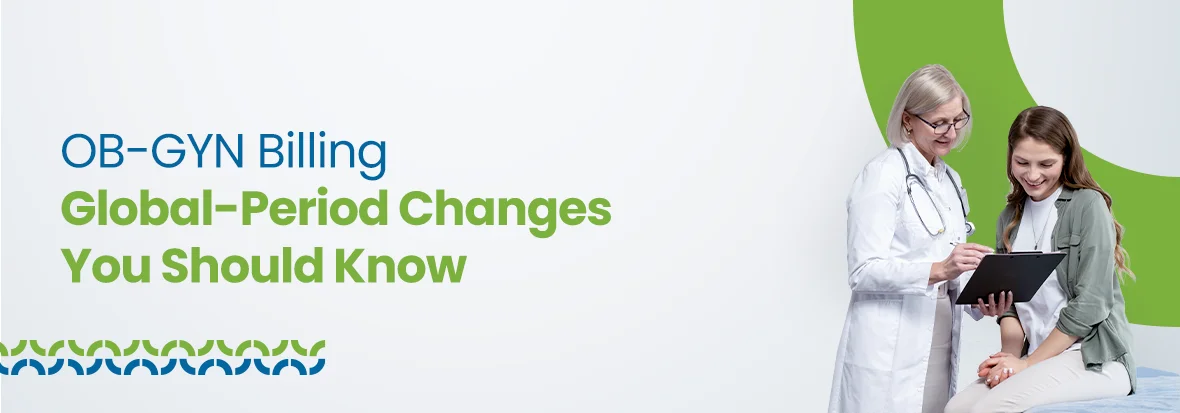If you’ve been hearing about major changes to OB-GYN billing in 2025, here’s the reality. The changes are smaller than the buzz suggests. Most of your OB-GYN global billing stays the same. Specialized OB GYN billing services help practices navigate these global packages efficiently. The core CPT codes haven’t changed, meaning the global period for CPT codes still applies and the global package concept remains identical.
Only one specific area changed. New telehealth CPT codes were introduced in 2025, though Medicare adoption is limited. Understanding these updates protects your revenue and keeps you compliant, with support from professional medical billing and coding services to highlight the role of expert billing support as improper obstetric global billing consistently ranks among the top causes of claim denials.
What is a Global Period in OB-GYN?
Global-period billing includes prenatal, delivery, and postpartum services within a single bundled reimbursement for obstetrical care, often called the obstetric package. Instead of billing separately for each prenatal visit, delivery, and postpartum care, you submit one comprehensive code covering the entire pregnancy journey from first prenatal visit through final postpartum check. The global package typically covers postpartum care for six weeks after delivery, after which additional visits require separate billing.
This differs from surgical global periods that use specific day counts, like 10-day or 90-day periods. where pre‑op visits and post‑op visits are bundled, to contrast surgical global periods with obstetric billing. OB-GYN global billing covers the entire scope of routine pregnancy care, essentially global maternity care billing regardless of duration. A 37-week pregnancy gets the same global code as a 42-week pregnancy.
Core Codes You Need to Know
Global Package Codes
Use when your practice provides comprehensive pregnancy care:
- 59400: Vaginal delivery with complete antepartum and postpartum care.
- 59510: Cesarean delivery with complete care.
- 59610: Vaginal birth after previous cesarean with complete care.
- 59618: Cesarean after attempted VBAC with complete care.
Component Codes
Use when you only handle part of the pregnancy care:
- 59409/59514: Delivery only (vaginal/cesarean).
- 59425: Antepartum care, 4-6 visits.
- 59426: Antepartum care, 7+ visits.
- 59430: Postpartum care only.
Decision Rule:
- Did your practice provide complete pregnancy care from prenatal through postpartum? Use global codes.
- Did you only handle portions while other providers managed other parts? Use component codes.
New Telehealth CPT Codes with Limited Medicare Recognition
New CPT codes were introduced for 2025, including 98000-98007 (audio-video), 98008-98015 (audio-only), and 98016 (brief communication). These codes inherently denote telehealth services and don’t require modifier 95. However, Medicare currently recognizes only 98016; 98000-98015 aren’t payable by Medicare (some commercial plans do cover them).
Virtual visits that are part of routine prenatal or postpartum care stay bundled within the global package. You cannot bill them separately just because they’re conducted via telehealth. However, telehealth visits for complications or issues outside the routine global package can be billed separately using appropriate evaluation and management codes for E/M services or code 98016 when applicable.
What Did NOT Change?
- CPT codes remain identical to 2024.
- Global package rules haven’t changed.
- Bundling principles stay consistent.
- Split and shared visit rules continue from 2024 – same substantive portion requirements and modifier FS usage (facility settings only).
- Services separately billable in 2024 remain separately billable in 2025.
Telehealth Rules for 2025
Bundled services remain bundled regardless of delivery method. Routine prenatal telehealth visits, virtual postpartum check-ups, and standard pregnancy education sessions delivered online are part of your global package payment.
What Can You Bill Separately?
- Telehealth visits addressing complications.
- Virtual care for unrelated medical issues.
- Care extending beyond routine postpartum period (typically after 6 weeks).
Coding Requirements
Use place of service code 02 for other telehealth locations or 10 for patient’s home. For traditional E/M codes, most commercial insurers require modifier 95, though Medicare requirements vary by MAC. The new telehealth CPT codes (98000-98015) don’t require modifier 95 since telehealth is inherent in the code descriptor, but remember that Medicare doesn’t accept these codes.
Important Note
Medicare’s expanded telehealth flexibilities (including home as originating site) run through September 30, 2025. Code 98016 replaces HCPCS G2012 for brief communications.
Making the Right Choice: Global vs Component Codes
Use Global Codes When
- Your practice handles the entire pregnancy.
- Same provider group does prenatal, delivery, and postpartum care.
Use Component Codes When
- Patient transfers between practices.
- You only do delivery without prenatal care.
- Another practice handles postpartum care.
Real Examples
- Patient moves mid-pregnancy: Original practice bills antepartum code, new practice bills global code.
- Hospital delivery with different OB group: Prenatal practice bills antepartum code, hospital group bills delivery-only code.
- You cover the call and deliver an unfamiliar patient: Bill delivery-only code.
Essential Modifiers for 2025
Essential Modifiers You Should Use
- Modifier 25: Significant, separately identifiable E/M service on same day as another procedure (note, this modifier is frequently misused in OB claims, so ensure proper documentation).
- Modifier FS: Split/shared visits in facility settings only (not office visits).
- Modifier 95: Telehealth services when using traditional E/M codes (not needed for new telehealth-specific CPT codes).
These procedure code modifiers ensure correct reimbursement.
Modifiers That Don’t Belong on OB Claims
- Modifier 90: Reference laboratory services (not for global periods)
- Modifier 91: Repeat lab tests (not for global periods).
These laboratory modifiers have nothing to do with obstetric global billing and create confusion on claims.
Understanding Different Payer Requirements
Medicare’s Approach to OB Global Billing
Medicare uses “MMM” indicator for obstetric global packages, distinguishing them from surgical global periods. Telehealth coverage continues through September 30, 2025, with patients able to receive services at home without geographic restrictions.
Commercial Insurance Variations
Many follow Medicare’s lead but may have specific differences:
- Exact number of postpartum visits included.
- Different telehealth requirements.
- State-specific mandates (like North Carolina’s new F-codes after July 1, 2025).
Always verify individual payer policies rather than assuming uniform coverage, because payer policies and medical claims reimbursement rules differ widely.
How to Properly Bill for OB/GYN in 2025?
Standard Pregnancy Care
Patient receives all prenatal care, delivers, and completes postpartum care with your practice.
Code: Use appropriate global code (59400, 59510, etc.)
Mid-Pregnancy Transfer
Patient transfers to your practice at 28 weeks, you provide ongoing care and delivery.
Code: Use global code because you provided substantial antepartum care plus delivery
Telehealth Postpartum Complications
Patient develops postpartum depression requiring virtual consultation beyond routine care.
Code: Use appropriate E/M code with modifier 95 or code 98016 with correct place of service
High-Risk Pregnancy
Patient needs additional monitoring visits beyond routine care for gestational diabetes.
Code: Bill global code plus separate E/M codes for medically necessary additional visits
Common Billing Mistakes to Avoid
- Wrong code selection: Using global codes when only providing partial care.
- Telehealth misunderstanding: Billing separately for routine virtual visits included in global package.
- Incorrect modifiers: Using lab modifiers on obstetric claims or misusing modifier 25 without proper documentation.
- Poor complication documentation: Failing to justify separately billable services.
- Transfer timing errors: Multiple providers billing global codes for same pregnancy.
Preparing for Changes in Late 2025
Monitor the September 30, 2025 expiration of expanded Medicare telehealth rules and proposed 2026 billing updates from ACOG and CMS. New telehealth codes may continue evolving based on utilization patterns.
Make sure to:
- Invest in staff training and coding certification
- Budget for billing software updates
- Establish robust documentation practices
- Create monitoring systems for billing performance
Key Takeaways
The 2025 changes to OB-GYN billing are minimal but important. New telehealth-specific CPT codes were introduced. These OB‑GYN coding updates expand your telehealth toolkit with limited Medicare recognition but core billing principles are identical. Success depends on proper code selection based on services actually provided, excellent documentation, and staying current with payer-specific policies.
Remember that bundled services stay bundled regardless of delivery method, component codes exist for partial care situations, and proper documentation remains your best defense against denials and audits.

